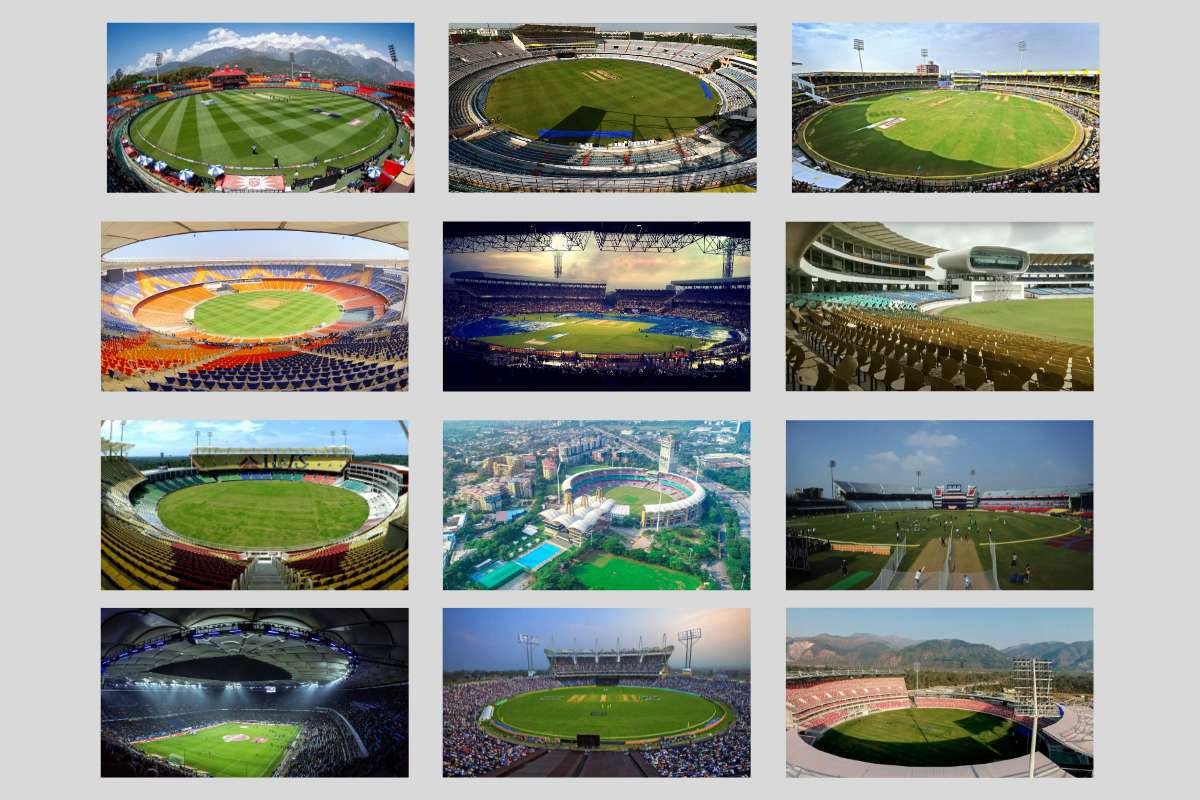Indian cinema is the heart and soul of Indian culture. These movies and their stars are part of the daily Indian conversation. Just to give you an idea of how big the Indian movie industry is, according to research, India produces the largest number of films globally. Our country produces over 1,200–1,500 films per year across 10+ languages. But this creates a question in everyone’s mind: Which is India’s highest grossing movie?
Is it Kantara? Is it Baahubali 2? Is it one of King Khan’s movies? The question is important too! Box office collection, especially in the post-COVID-19 era, is extremely critical for the film industry.
In this blog, we shall obviously take a look at India’s highest grossing movie, but we will also take a look at 20 others that took that spot during their time. So, without wasting too much time, let’s get straight into it.
20 Highest-Grossing Indian Movies of All Time: A Look at Cinema’s Rich History
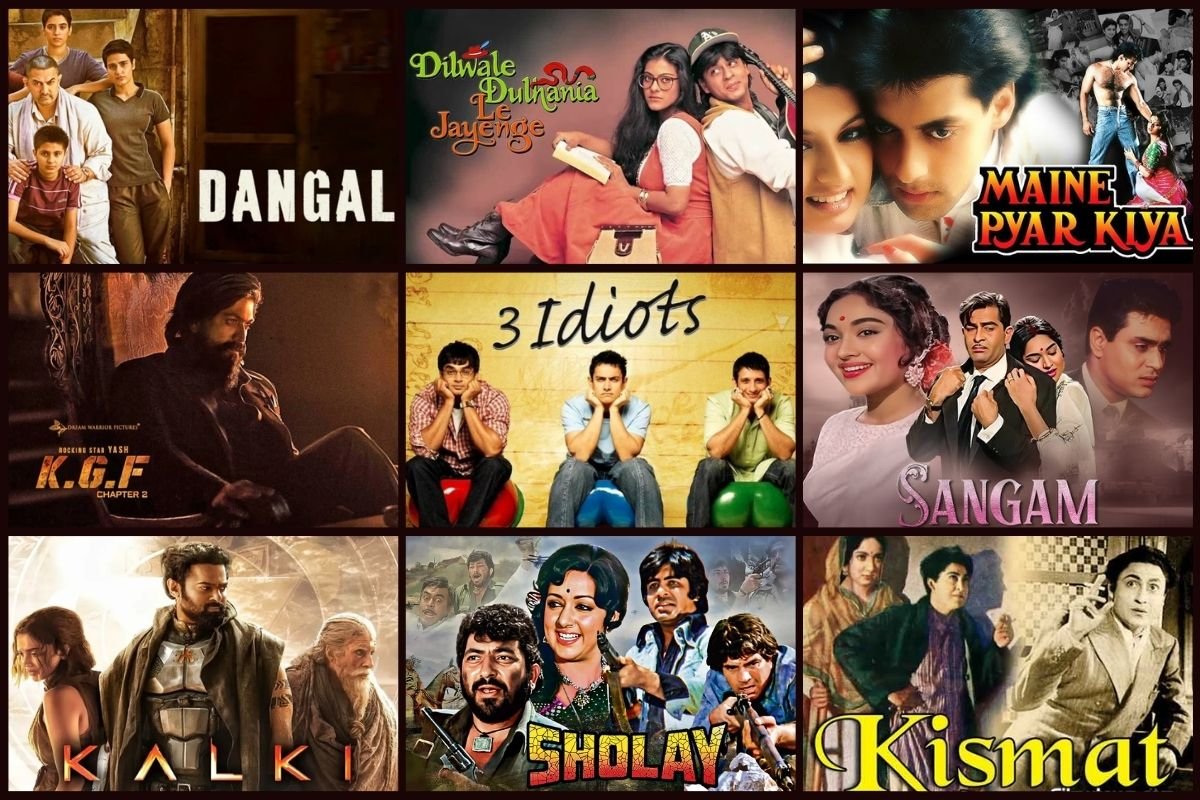
We have found the 20 India’s highest grossing movies from every era. The list you will see below is a culmination of all the different movies ranked according to their era.
So, without wasting our time, let’s find out India’s highest grossing movie of all time.
| Era | Film | Year | Language | Global Box Office Collection |
|---|---|---|---|---|
| Modern Era (2000s–Present) | Dangal | 2016 | Hindi | ₹2,024 crore |
| Pushpa 2: The Rule | 2024 | Telugu | ₹1742 crore to ₹1743 crore | |
| Baahubali 2: The Conclusion | 2017 | Telugu | ₹1,740 crore | |
| KGF Chapter 2 | 2022 | Kannada | ₹1200 crore to ₹1300 crore | |
| RRR | 2022 | Telugu | ₹1275 crore to ₹1275.51 crore | |
| Kalki 2898 AD | 2024 | Telugu | ₹767.25 crore | |
| 1990s–Early 2000s | Hum Aapke Hain Koun..! | 1994 | Hindi | Approximately ₹128 crore |
| Dilwale Dulhania Le Jayenge | 1995 | Hindi | ₹102.5 crore | |
| Raja Hindustani | 1996 | Hindi | Approximately ₹76.38 crore | |
| 3 Idiots | 2009 | Hindi | ₹350 crore | |
| Ghajini | 2008 | Hindi | Approximately ₹189 crore | |
| 1970s–1980s | Sholay | 1975 | Hindi | ₹35 crore |
| Deewaar | 1975 | Hindi | ₹50 crore | |
| Aandhi | 1975 | Hindi | ₹1 crore | |
| Maine Pyar Kiya | 1989 | Hindi | ₹45 crore | |
| Ram Teri Ganga Maili | 1985 | Hindi | ₹19 crore | |
| Golden Age (Late 1940s–1960s) | Mughal-E-Azam | 1960 | Hindi | ₹11 crore |
| Sangam | 1964 | Hindi | Approximately ₹8.80 crore | |
| Phool Aur Patthar | 1966 | Hindi | ₹0.62 crore | |
| Kismet | 1943 | Hindi | ₹1.35 crore |
Modern Era (2000s–Present)
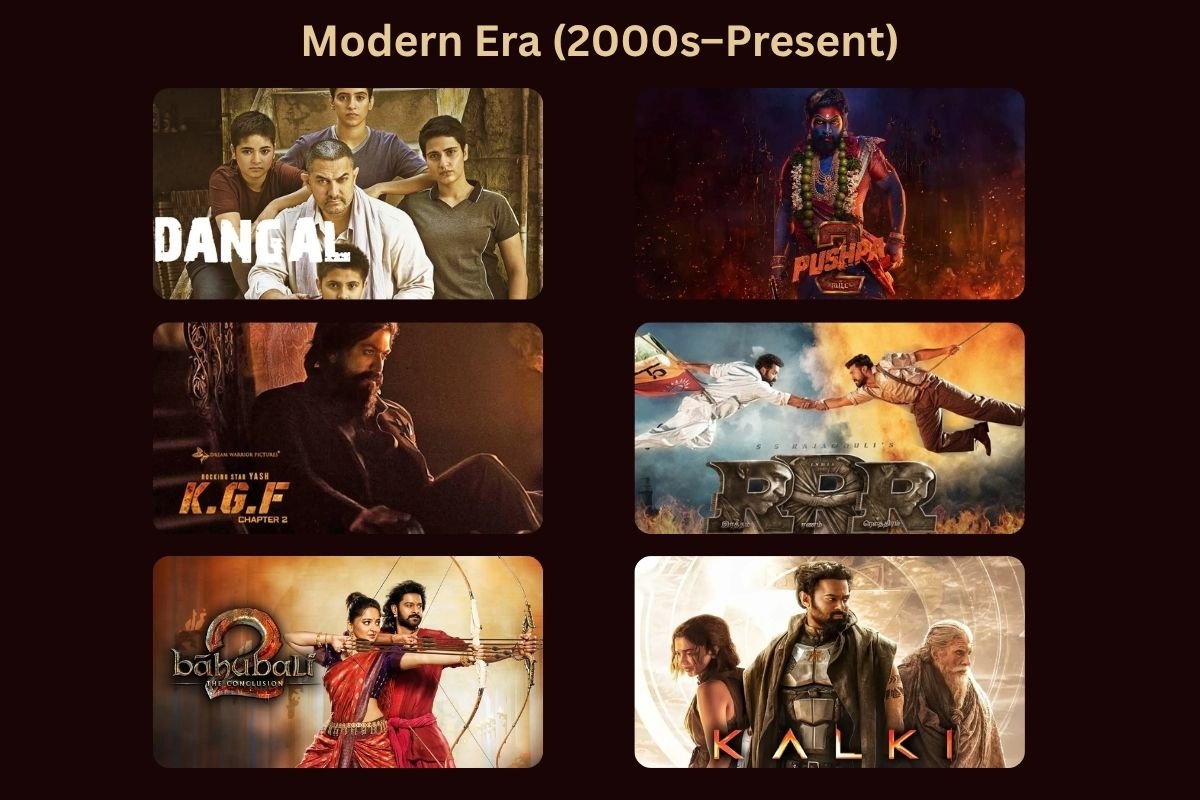
1. Dangal
- Production Budget: ₹85 crore to ₹90 crore
- Global Box Office Collection: Around ₹2,024 crore
- Release Date: 23 December 2016
Released in 2016. Dangal was based on the real-life of the wrestler Geeta Phogat and her father, Mahaveer Phogat. The movie resonated strongly for its depiction of breaking gender stereotypes and championing women’s success in a male-dominated field (wrestling), particularly in a conservative societal setting.
The complex themes of a father’s sacrifice, dedication, and strict training to fulfill his dream through his daughters struck a deep, emotional chord. The core themes of filial piety, parental sacrifice, and gender equality debates resonated intensely with Chinese audiences in particular.
2. Pushpa 2: The Rule
- Production Budget: Between ₹400 crore and ₹500 crore
- Global Box Office Collection: ₹1742 crore to ₹1743 crore
- Release Date: 4 Dec 2024
Pushpa 2: The Rise is India’s highest grossing movie in 2025. The continuation of Pushpa Raj’s story, a labourer turned red sandalwood smuggler, who has now become a powerful international kingpin. The plot centres on his conflict with the vengeful police officer SP Bhanwar Singh Shekhawat, played by Fahadh Faasil, and his ascent to political manipulation while protecting his family.
Initial reports indicate the movie earned over ₹1471 crore in India. This movie has established new box office benchmarks and made Allu Arjun the highest-paid actor in India. It was a game-changer in the Telugu film industry.
3. Baahubali 2: The Conclusion
- Production Budget: ₹250 crore
- Global Box Office Collection: ₹1,740 crore
- Release Date: 28 April 2017
After continuously asking, “Why did Katappa kill Baahubali?” we finally had an answer in 2017. SS Rajamouli’s Baahubali 2: The second part of the saga showcased the titular hero’s fall from grace due to a conspiracy by the jealous Bhallaladeva.
The principal cast featured Prabhas, Rana Daggubati, Anushka Shetty, and Sathyaraj. The film received immense praise for its visual grandeur and direction. A monumental success, it became India’s first ₹1000 crore film, with global earnings surpassing ₹1700 crore.
4. KGF Chapter 2
- Production Budget: ~ ₹100 Crores
- Global Box Office Collection: ₹1200 crore to ₹1300 crore
- Release Date: 14 April 2022
The epic continuation follows Rocky’s reign as the unchallenged king of the Kolar Gold Fields. In this part, he is forced to confront powerful new foes like the ruthless Adheera and the commanding Indian Prime Minister, Ramika Sen. Starring Yash, Sanjay Dutt, and Raveena Tandon, the film was lauded for its massive scale and high-octane action sequences.
KGF Chapter 2 received an extraordinary reception during its release, breaking records globally. Just like its predecessor, which was India’s highest grossing movie during its year, it stands as one of the highest-grossing Indian films ever, with collections surpassing ₹1200 crore worldwide.
5. RRR
- Production Budget: ₹550 crore
- Global Box Office Collection: ₹1275 crore to ₹1275.51 crore
- Release Date: 24 March 2022
RRR was a cultural phenomenon of 2022. This movie took India to the world stage and even to the Academy Awards. The ‘Naatu-Naatu’ hook step truly hooked the entire world. We had an entire year of every person of every race doing ‘Naatu Naatu.’
Set in 1920s India, this epic action drama imagines a fictional friendship between legendary revolutionaries Alluri Sitarama Raju and Komaram Bheem. Their powerful struggle against the British Raj drives the plot. It was one of the best of SS Rajamouli’s works.

How the Rich History of Films in India Led to the Rise of Bollywood?
Read about the history of films in India and the rise of Bollywood and its Superstars.
6. Kalki 2898 AD
- Production Budget: ₹550 crore
- Global Box Office Collection: ₹1275 crore to ₹1275.51 crore
- Release Date: 27 June 2024
Set in a dystopian 2898 AD, Kalki 2898 AD blends Hindu mythology and science fiction, chronicling a bounty hunter’s involvement in a prophecy concerning the final avatar of Vishnu. The star-studded ensemble includes Prabhas, Deepika Padukone, Amitabh Bachchan, and Kamal Haasan.
Made on a reported budget of ₹550 crore, the film received mixed critical reviews but was a massive box office success. It achieved a total worldwide gross collection exceeding INR 1000 crore. This helped in establishing the movie as one of the highest-grossing Indian films globally.
1990s–Early 2000s
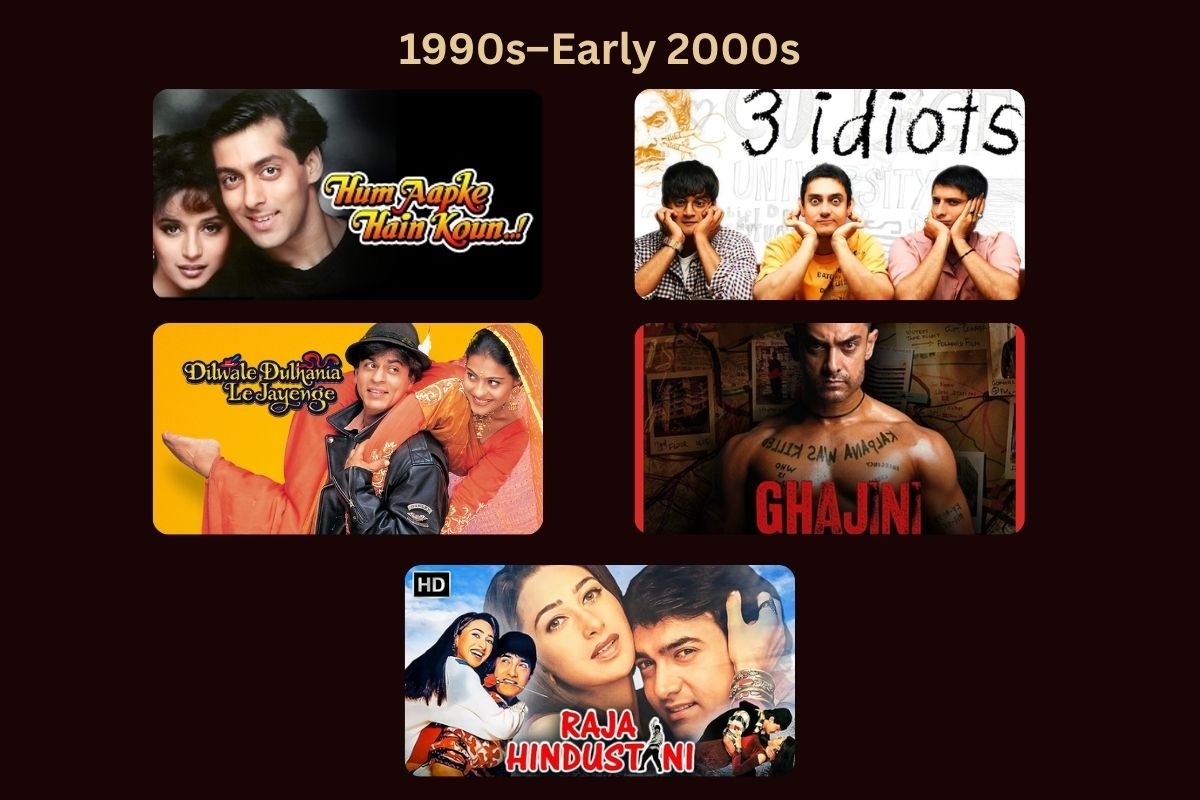
Now, let’s move on to the movies of the pre-Internet era. Here are 5 of the highest-grossing movies of India between the late 80s and early 2000s.
7. Hum Aapke Hain Koun..!
- Production Budget: ₹4.5 crore
- Global Box Office Collection: Approximately ₹128 crore
- Release Date: 5 Aug 1994
‘Hum Aapke Hain Koun..!’ is a classic Bollywood movie. It was jam-packed with a solid star cast. With Salman Khan and Madhuri Dixit as the face of the project, it was no brainer that it was going to be India’s highest grossing movie of its time.
This iconic family drama follows Prem and Nisha, who fall deeply in love while their families arrange the marriage of their elder siblings. A sudden tragedy threatens their union and forces them to choose between personal happiness and family honour. It is a classic part of everyone’s childhood.
8. Dilwale Dulhania Le Jayenge
- Production Budget: ₹4 crore
- Global Box Office Collection: ₹102.5 crore
- Release Date: 20 Oct 1995
If this were the list of the most popular Indian movies, DDLJ would have been on top of it. This movie is synonymous with Bollywood worldwide. Whenever someone thinks of Bollywood, it is more than likely that they are thinking about this musical rom-com starring Shah Rukh Khan and Kajol.
The plot follows two London-based Indian youths, Raj and Simran, who fall in love during a European backpacking trip. Simran’s traditional father, Baldev Singh, has already betrothed her to another man in Punjab. The drama unfolds as Raj follows her to India, refusing to elope and instead striving to win Baldev’s difficult blessing for their union.
9. Raja Hindustani
- Production Budget: ₹5.75 crore
- Global Box Office Collection: Approximately ₹76.38 crore
- Release Date: 15 Nov 1996
The story follows the tumultuous marriage between the wealthy, modern-day city girl, Aarti, and the humble, traditional taxi driver, Raja. Their deep love faces severe class prejudice and family interference. After their separation, Raja battles tirelessly to reclaim his wife and their son, proving that true affection transcends social divides.
Pardesi Pardesi, a song that comes at the central point of the movie, is still loved by everyone. It perfectly encapsulates the longing and desperation of separation. But that was not the only song that captured everyone’s heart. This movie had numerous songs that captured the hearts of fans everywhere.
10. 3 Idiots
- Production Budget: ₹55 crore
- Global Box Office Collection: Approximately ₹350 crore
- Release Date: 25 Dec 2009
3 Idiots was a cultural milestone in Indian cinema. Even if we look beyond it being India’s highest grossing movie in 2009, we still have to appreciate the impact it had on the education of Indian society. It is one of the most famous movies of India abroad. People from South Korea, the USA, Germany, and every other country praise it abundantly.
The movie chronicles the lives of three engineering students navigating the rigid, competitive academic system. It centres on the non-conformist Rancho (Aamir Khan), who encourages his friends to follow passion, not pressure. Years later, his companions embark on a hilarious journey to find the eccentric genius who disappeared after graduation.
11. Ghajini
- Production Budget: ₹65 crore
- Global Box Office Collection: Approximately ₹189 crore
- Release Date: 25 Dec 2008
India’s Christmas was different in 2008. Aamir Khan’s Ghajini followed the tale of Sanjay Singhania and Kalpana Shetty. The story of revenge has a unique spin thanks to Anterograde amnesia. This was one of Aamir Khan’s best performances in his career. The movie was one of the best remakes, and dare I say, better than the original.
As for the plot, the intense action-thriller centres on wealthy businessman Sanjay Singhania, who suffers from anterograde amnesia after a brutal attack. Unable to form new memories, he meticulously uses tattoos, notes, and photos to track the criminal, Ghajini. His sole mission is to violently avenge the murder of his fiancée, Kalpana.
1970s–1980s
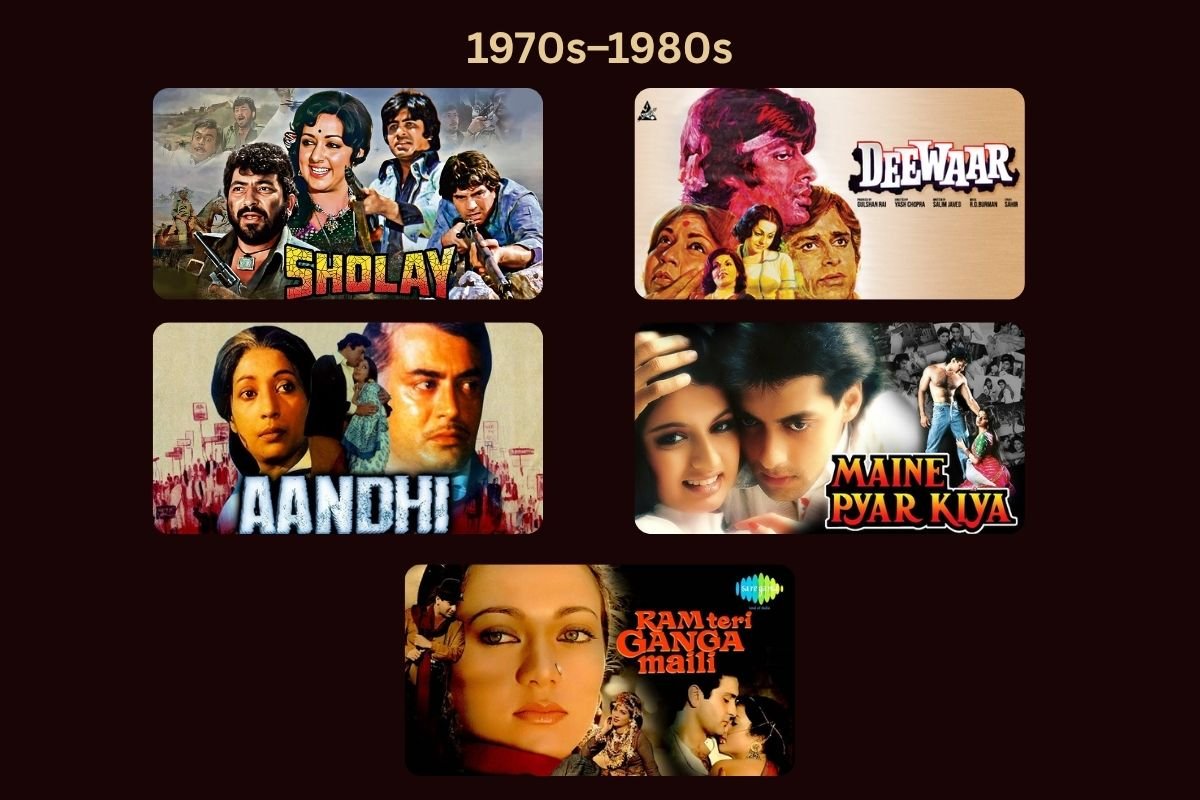
And that was the millennial era movies, what about Gen X? Let’s talk about the movies that ruled the box office during the time of our parents.
12. Sholay
- Production Budget: ₹3 crore
- Global Box Office Collection: ₹35 crore
- Release Date: 15 Aug 1975
Sholay might be the most Bollywood-like movie of all time. It has everything Bollywood is known for. A funny, charming hero, his beautiful love interest, comedy, classic songs, emotional moments, crazy action sequences, and Amitabh Bachchan. You can guess its popularity by the fact that every child in India knows ‘Kab Hai Holi?’ and ‘Kitne Aadmi the?’ by heart.
The movie made ₹35 crore at the global box office, which, when adjusted to inflation, rounds up somewhere around ₹1,630 crore. An amount that even KGF 2, being the second part of a successful movie, could not cross. The movie gave us songs like ‘Yeh Dosti Hum Nahi Todenge,’ which is still synonymous with friendship even after 50 years.
13. Deewaar
- Production Budget: ₹1.5 crore
- Global Box Office Collection: ₹4.75 crore
- Release Date: 24 Jan 1975
Deewar gave Amitabh Bachchan his popular angry young man persona. After the movie’s release, Amitabh Bachchan became the face of the brooding, angry anti-hero in Indian cinema. The screenplay was packed with legendary, whistle-worthy lines. Even the most famous “Mere paas Maa hai,” which became a permanent fixture in Indian popular culture, was from this movie.
The narrative, cleverly disguised as a family drama, offered a poignant commentary on class divide, unemployment, and the failure of the state. This made it feel incredibly relevant and real to the audience of that era. The movie made ₹4.75 crore in its box office run, which, when adjusted to today’s rates, rounds up to ₹950 crore.
14. Aandhi
- Production Budget: ₹7 lakh
- Global Box Office Collection: ₹1 crore
- Release Date: 13 Feb 1975
The film was released in 1975 and faced a ban during the national Emergency. The story of a female politician, Aarti Devi, played by Suchitra Sen, was rumoured to be based on the life of then-Prime Minister Indira Gandhi. This controversy generated immense public curiosity and discussion, significantly boosting its reputation.
Sanjeev Kumar won the Filmfare Best Actor Award for his restrained portrayal of J.K., the estranged husband. The film, directed by Gulzar, was praised for its mature and sensitive handling of a complex relationship. The non-linear narrative, told through flashbacks, effectively explored the conflict between personal life and political ambition.
15. Maine Pyar Kiya
- Production Budget: ₹2 crore and ₹4 crore
- Global Box Office Collection: ₹45 crore
- Release Date: 29 Dec 1989
Before he was Bollywood’s Bhaijaan, Salman had his breakout as a soft romantic hero. Maine Pyar Kiya offered a wholesome, musical, and aspirational romance that perfectly captured the imagination of that generation. The film popularized famous lines like “Dosti ka ek usool hai, no sorry, no thank you” and the iconic “FRIEND” cap, which became a massive fashion trend and the film’s first-ever merchandise.
One of the reasons why this was India’s highest grossing movie of 1989 was the chemistry between Salman Khan and Bhagyashree. They were believable couples with innocent love. And the soundtrack, composed by Raamlaxman with lyrics by Asad Bhopali, was a major blockbuster in its own right. Songs like “Dil Deewana,” “Mere Rang Mein,” and “Kabootar Ja Ja Ja” are still incredibly popular, remaining classics for years.
16. Ram Teri Ganga Maili
- Production Budget: ₹1.44 crore
- Global Box Office Collection: ₹19 crore
- Release Date: 25 July 1985
This was the last movie Raj Kapoor worked on. The movie’s popularity was due to its song, sensationalism, and a potent social message for the society of that era. When we keep aside the sensual reasons the movie was popular, the film used the journey of the pure, innocent village girl, Ganga, as a metaphor for the holy River Ganga’s journey from the pure Himalayas (Gangotri) to the polluted plains (Calcutta).
The title, meaning “Ram, your Ganga is polluted,” was a direct critique of the moral corruption and hypocrisy in urban Indian society and politics. And that was a theme that resonated with the masses. And all of this made Ram Teri Ganga Maili one of the highest grossing films of the 80s.
Golden Age (Late 1940s–1960s)
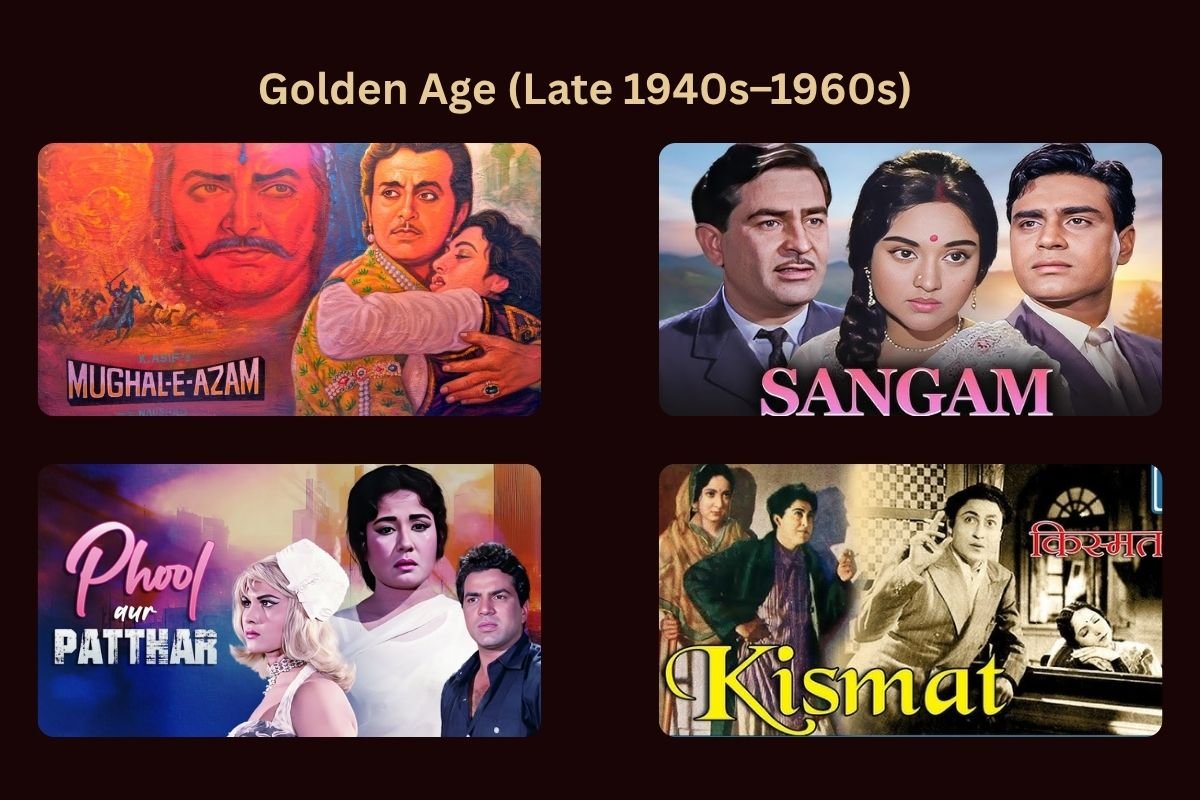
Now, we are coming to the end of the list. Let’s see the box office champions in the initial days of Indian Cinema. Here are the highest grossing films of the golden age.
17. Mughal-E-Azam
- Production Budget: ₹1.5 crore
- Global Box Office Collection: ₹11 crore
- Release Date: 5 August 1960
Even when you read the name, you can already hear the voice of Prithviraj Kapoor saying, ‘Salim.’ The movie was famous for its dialogue and the grand scale, which was unseen during that era. The dialogue, like ‘Pyar kiya toh darna kya,’ has been immortalized in the minds of all Bollywood fans.
The film was the most expensive Indian film made up to that point. It took nearly 16 years (1944–1960) to complete due to its massive scale. When the movie production started, India was still under British rule. It cost ₹1.5 crore to make the movie; to give you a perspective, an average movie during that time cost ₹1–2 lakh for production.
18. Sangam
- Production Budget: ₹0.80 crore to ₹1.60 crore
- Global Box Office Collection: Approximately ₹8.80 crore
- Release Date: 18 June 1964
During a time when Bollywood movies were made inside sets in studios, Raj Kapoor did something so revolutionary that it became a blueprint for filmmakers to come. He shot Sangam extensively abroad. It had locations like London, Paris, and Switzerland. This international scale and stunning colour cinematography by Radhu Karmakar offered Indian audiences an unprecedented, luxurious visual experience.
And it wasn’t just an expensive film, it was also the longest film of that era, nearly four hours with two intervals. The film made around ₹8.80 crore at the box office, making it into India’s highest grossing movie of 1964. In conclusion, the combination of its technical innovation, emotional depth, and chart-topping music cemented Sangam’s status as an All-Time Blockbuster and a cult classic.
19. Phool Aur Patthar
- Production Budget: ₹0.62 crore
- Global Box Office Collection: Approximately ₹8.80 crore
- Release Date: 14 Aug 1966
Dharmendra was the second most popular actor in the Soviet Union after Raj Kapoor, and this movie was the reason behind it. This film was the breakthrough that established Dharmendra as an action star and the “He-Man” of Bollywood. His rugged, contrasting role as Shaka, the “Rock” (Patthar), a criminal redeemed by a pure woman, strongly resonated with audiences.
The film was one of the highest-grossing films of 1966 in India. It was also one of the first few to achieve significant international success, particularly in the Soviet Union. All of this solidified its status as a blockbuster and an all-time classic.
20. Kismet
- Production Budget: ₹2 lakh
- Global Box Office Collection: Approximately ₹2 crore
- Release Date: 9 Jan 1943
Now let’s talk about the first of India’s highest grossing movies—Kismet. It had a run of three years in the theatres. It was the first movie to cross ₹1 crore at the box office. To put into perspective, India’s overall GDP was approximately ₹3 crore ($200 billion in 1990 international dollars) in the 1940s.
The film introduced an anti-hero protagonist, an idea that was extremely revolutionary for the time. Released during the Quit India Movement, the film cleverly included the patriotic song “Door Hato O Duniya Walon, Hindustan Hamara Hay.” The veiled anti-British message was clearly understood by the Indian public, despite appearing to target the Axis powers in World War II.
Importance of Box Office in Indian Cinema
Now that we have looked at the highest grossing movies in Indian Cinema, why are their earnings so important? Let’s talk about that.
See, the box office serves as the main measure of a film’s financial success and popularity in India. It is an indicator of whether a film is liked by the audience. But is that why the box office is important?
No! The main reason is the Indian economy. The Indian box office generated a gross revenue of approximately ₹11,833 crore (about 118 billion rupees) in 2024. According to data released by Deloitte, the film and TV sector contributes around INR 50,000 crore, which was about 0.5% of India’s GDP at the time in 2013.
Another recent study suggests that the Indian entertainment and media industry is expected to grow at a rate of 9.7% annually and reach a market size of ₹5.9 lakh crore (US$73.6 billion) by FY27.
See, India is home to most of the largest film industries in the world. And collectively, they produce the highest number of films annually and have the second-highest cinema screen count worldwide.
And that is why the box office performance of India’s highest grossing movie matters so much for Indian cinema.
Trying to Understand the Shift from Bollywood to Regional Cinema
When you look at the list of highest-grossing movies, you must’ve noticed something. In its initial days, all of India’s highest grossing movies were from Bollywood, but recently there has been a shift to regional cinema.
And you must ask why? Well, here’s the answer. Look at the movies in the list. All of them are story-driven tales offering something new to the audience.
If we look at Mughal-e-Azam, it was a revolutionary story with a scale so grand that it was unprecedented for its time. If we look at Kismet, we see the audience finding out about anti-heroes. Sangam took movies out of the set and into the real world.
Even modern movies like 3 Idiots talk about a very important topic in modern society. Dangal told a family’s story, a heart-warming, tear-jerking story, nonetheless. Pushpa 2 is the classic rags-to-riches. Baahubali’s success was built on suspense and mystery.
The point is, the audience is always looking for something new and revolutionary. And that’s why we are seeing a shift to regional cinema.
Conclusion:
The history of Indian cinema is a captivating journey defined by spectacular box office achievements and cultural milestones. We explored how films like the epic Mughal-E-Azam and the blockbuster Sholay defined their eras, each setting a new benchmark for popularity and scale. The evolution to today’s massive-scale productions like Dangal and Pushpa 2: The Rule clearly showcases the dramatic growth of the industry, pushing the boundaries of what is considered India’s highest grossing movie.
From the pioneering anti-hero of Kismet in 1943 to the global sensation of recent Telugu and Hindi films, the list reveals an industry constantly reinventing itself. These 20 films are not just box office numbers; they represent the rich, diverse storytelling that remains the heart of Indian culture. Ultimately, this journey through history provides a clear answer to the central question: what is India’s highest grossing movie?
FAQ
1. Which film holds the record for the longest continuous theatrical run in India?
Dilwale Dulhania Le Jayenge (DDLJ) holds this record. It ran continuously for over 25 years at the Maratha Mandir Theater in Mumbai.
2. What is the difference between net collection and gross collection?
Gross collection is the total ticket sales revenue. Net collection is the gross collection minus the entertainment tax paid to the government, showing a film’s actual business.
3. Which non-Hindi film was the first to cross ₹100 crore globally?
S. S. Rajamouli’s Telugu film Baahubali: The Beginning (2015) was the first non-Hindi film to earn over ₹100 crore worldwide. This movie set a new box office standard for regional cinema.
Thanks for Reading!
See More
12 Best Business Movies That Inspire, Educate, and Entertain




